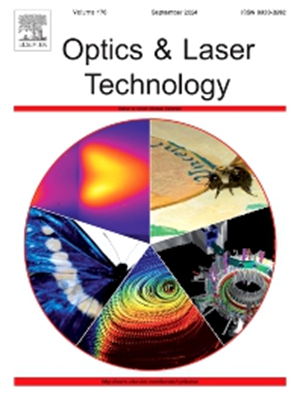激光冲击锻辅助电弧修复DH36钢残余应力及力学性能研究
IF 4.6
2区 物理与天体物理
Q1 OPTICS
引用次数: 0
摘要
激光冲击锻造辅助电弧修复(LSF-AR)技术是近年来发展起来的新技术。为了验证该技术的有效性,通过数值模拟和实验对比研究了电弧修复(AR)和LSF-AR修复DH36钢的残余应力和力学性能。首先将修复试样的模拟变形值与实验测量数据进行比较,以验证模拟设置的有效性。然后,对数值模拟和实验测量得到的残余应力分布进行了对比分析,两者吻合较好。结果表明:AR试样焊缝残余拉伸应力显著,LSF-AR试样焊缝中心残余拉伸应力由395.4 MPa降至204.3 MPa;与AR样品相比,LSF-AR样品的抗拉强度和伸长率都有所提高。本研究验证了在AR过程中应用LSF方法实现低残余应力和高性能修复的可行性。本文章由计算机程序翻译,如有差异,请以英文原文为准。
Investigations on the residual stress and mechanical properties of DH36 steel repaired by laser shock forging assisted arc repair method
The laser shock forging assisted arc repair (LSF-AR) technology is newly developed. To validate the effectiveness of this technology, the residual stress and mechanical properties of DH36 steel repaired by arc repair (AR) and LSF-AR were comparatively investigated through numerical simulation and experiment. The simulated deformation values of the repaired sample were first compared with the experimental measured data to confirm the validity of the simulation settings. Afterwards, a comparative analysis was conducted on the residual stress distributions acquired from both numerical simulations and experimental measurements, which were found in good agreement. The results indicated that the AR sample exhibited significant tensile residual stress (TRS) in the weld seam, but LSF-AR notably reduced this TRS, with the TRS at the weld seam center decreasing from 395.4 MPa to 204.3 MPa. Compared to the AR sample, the LSF-AR sample showed improved tensile strength and elongation. This study validated the feasibility of applying LSF method during AR processes to achieve low residual stress and high-performance repair.
求助全文
通过发布文献求助,成功后即可免费获取论文全文。
去求助
来源期刊
CiteScore
8.50
自引率
10.00%
发文量
1060
审稿时长
3.4 months
期刊介绍:
Optics & Laser Technology aims to provide a vehicle for the publication of a broad range of high quality research and review papers in those fields of scientific and engineering research appertaining to the development and application of the technology of optics and lasers. Papers describing original work in these areas are submitted to rigorous refereeing prior to acceptance for publication.
The scope of Optics & Laser Technology encompasses, but is not restricted to, the following areas:
•development in all types of lasers
•developments in optoelectronic devices and photonics
•developments in new photonics and optical concepts
•developments in conventional optics, optical instruments and components
•techniques of optical metrology, including interferometry and optical fibre sensors
•LIDAR and other non-contact optical measurement techniques, including optical methods in heat and fluid flow
•applications of lasers to materials processing, optical NDT display (including holography) and optical communication
•research and development in the field of laser safety including studies of hazards resulting from the applications of lasers (laser safety, hazards of laser fume)
•developments in optical computing and optical information processing
•developments in new optical materials
•developments in new optical characterization methods and techniques
•developments in quantum optics
•developments in light assisted micro and nanofabrication methods and techniques
•developments in nanophotonics and biophotonics
•developments in imaging processing and systems

 求助内容:
求助内容: 应助结果提醒方式:
应助结果提醒方式:


